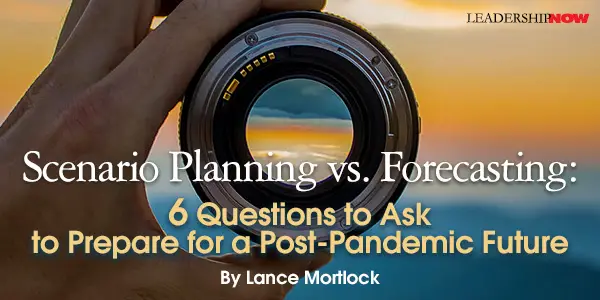 |
 |
05.12.21

Scenario Planning vs. Forecasting: 6 Questions to Ask to Prepare for a Post-Pandemic Future
AS WE finally start to see the light at the end of the tunnel of the catastrophic COVID-19 pandemic, many business leaders are looking for ways to better anticipate future disruptions and prepare for uncertainty ahead. There is often confusion between scenario planning and forecasting, with the terms used interchangeably and inconsistently. But these are different methods that involve specific activities, outcomes and value add. Scenario planning is focused on the future and involves defining different stories behind different paths that will lead to that future. You could also say it is based on a dynamic sequence of interacting events, causal processes, and critical decision points. It offers enhanced flexibility and preparedness to deal with risk and uncertainty instead of purely quantitative forecasting. It is about understanding multiple plausible futures without blinkers on, identifying what could happen, and describing that outcome in a compelling, engaging narrative. Scenarios are also collaborative—typically involving teams of people, often from various levels within an organization—and there is often a creative dimension, as opposed to being purely based on quantitative number-crunching. Scenarios provide longer-term, multiple futures based on unknown risks and uncertainties (e.g., the results of a U.S. election). Forecasts, on the other hand, are constructed on the assumption that the world in the future looks much like it does today. Forecasting is a less creative process and does not anticipate significant shifts in the business environment, which can cause considerable challenges for organizational strategy and a firm’s performance. Also, forecasts do not factor in risks and uncertainty as part of a broader stakeholder dialogue or research exercise. Instead, forecasting uses quantitative inputs and methodology to help predict what will, or should, happen in the future, mainly by interpreting historical data. Forecasting is a shorter-term tool that provides certainty based on known variables in the system (e.g., passenger traffic for airlines). To put it more bluntly: Forecasts offer one possible future, whereas scenarios offer multiple possible futures. Neither tool is better than the other; they simply offer different approaches to solving problems and should be used in a complementary way. The table below provides a more detailed contrast between scenario planning and forecasting, comparing various features and explaining the differences:
When deciding which tool to apply to a problem or opportunity, there are six typical questions that you can ask to help identify whether scenario planning or forecasting will be more effective:
As Paul Saffo, a technology forecaster based in Silicon Valley, said, “the goal of forecasting is not to predict the future, but to tell you what you need to know to take meaningful action in the present.” In a world of so many different management tools at the fingertips of leaders, it’s vital to ensure you select the right one to drive the outcomes you need to be successful.  
Posted by Michael McKinney at 11:11 AM
|
BUILD YOUR KNOWLEDGE
 

How to Do Your Start-Up Right STRAIGHT TALK FOR START-UPS 
Grow Your Leadership Skills NEW AND UPCOMING LEADERSHIP BOOKS 
Leadership Minute BITE-SIZE CONCEPTS YOU CAN CHEW ON 
Classic Leadership Books BOOKS TO READ BEFORE YOU LEAD |